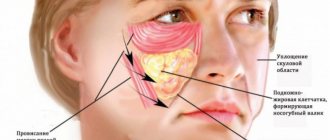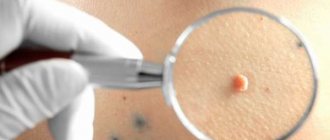Is it possible to pull hair out of a mole? The fluff growing on moles is not as noticeable as coarse tufts of hair.
They do not bother anyone, but they spoil the aesthetic appearance if the mole is localized on the face or in the area of open dermis.
Hair on a mole is not an indicator of the development of a cancerous tumor, but quite the opposite - there are living cells here, not oncogenic ones, which means that the neoplasm is benign.
- Why does hair grow on a mole?
- The appearance of hairs on a mole
- How is hair removal from a mole done?
- Laser and electrolysis for mole hair removal
- Trimming hairs on a mole
What does a hair on a nevus mean?
A mole is essentially a congenital or acquired skin defect. It appears due to the accumulation of pigment cells in the epidermis and is usually considered a completely benign neoplasm. Small moles usually don't attract the attention of their owners, but if hair grows from them, they become much more difficult to ignore. And if there is a large mole with hairs on the body, then it causes severe anxiety and concern.
By the way, doctors assure that such a symptom does not indicate any pathology. Hairy nevi are a natural physiological phenomenon.
Hair can grow on different parts of the body. They appear only in mature cells with a good blood supply. Pigmentation, including local one, does not in any way affect the activity of hair follicles. Nevertheless, if you have strange black and brown nevi on your body, you should still show them to a doctor, he will help you figure out why hair appeared on them and whether something needs to be done about it.
Could they have melanoma?
A popular theory among many people is that the presence of hair on a mole guarantees its good quality. They say cancer processes usually disrupt the activity of hair follicles. However, experienced dermatologists assure that such an opinion is just a myth that has no basis. Hair grows from the follicular layer, which is lower than the growth area of the mole. Accordingly, hairs can even be found on cancerous tumors.
Also very popular is the view that hair from a mole begins to fall out when it becomes malignant. However, this opinion is erroneous and quite dangerous, since in case of cancer, hair stops growing only after the tumor penetrates deep enough into the tissue and, possibly, begins to metastasize.
On a wart
A wart is a benign skin tumor caused by the activity of the HPV virus. This tumor can appear in different parts of the body, but hair usually does not grow on it. However, tumors that look like warts can appear on the skin, but only a dermatologist can understand what they really are. In particular, convex moles, which can differ in color - be light or dark, are considered quite common. Hairs often grow from them.
On a birthmark
A birthmark is a congenital nevus, the causes of which lie in the accumulation of melanocytes (skin cells that produce pigment) in the skin. Such a pigmented neoplasm is most often safe, although exceptions are possible.
Hair (both black and gray) may well grow from a birthmark, just like from a mole. Dye cells accumulate in the upper layers of the skin, while hair follicles are located much lower.
Why does hair grow on a mole?
A mole with hair appears on the face and/or body as a result of:
- genetic factor - transmitted from parents to children;
- fluctuations in hormonal levels, for example, in pregnant women or adolescents, in women during menopause;
- ultraviolet skin stress, due to which melanin production is activated. With an excess of melanin, the neoplasm can transform into malignant.
Age spots in children can appear up to 10 years of age, during puberty and pregnancy, as well as in women during menopause.
If it has increased, but there are still hairs on it?
Sometimes moles on the body begin to change - they increase in size, become lumpy and uneven. Doctors emphasize that a nevus that changes its structure must in any case be shown to a dermatologist as soon as possible. The presence or absence of hair on a mole makes no difference.
Laser and electrolysis for mole hair removal
To remove an unwanted tumor with a tuft of facial hair, you can use laser correction.
This modern cosmetology product is prescribed by a doctor, especially when the structure and size of the nevus changes.
You can do electrolysis or remove it with a laser if a large colorless mole grows on the scalp (in the scalp) and there is a risk of damaging it with a comb or burning it with chemicals during dyeing and perming.
After electrolysis, the skin may turn red and experience some irritation. These symptoms disappear within a week.
If a flat mole has grown on a child’s head, it is difficult to damage it, unlike a hanging neoplasm, it must be removed.
Why do they appear in the place of the remote one?
Mole removal is a fairly common procedure. Some nevi are removed solely for cosmetic reasons, while doctors strongly recommend getting rid of others (if there is a high risk of malignancy). At the site of the removed mole, a trace usually remains - a small scar. Its severity directly depends on the chosen removal method.
After some time, hair may begin to grow at the site of the removed mole. This phenomenon is absolutely normal and does not require any close attention.
Hair removal methods
There are several methods for removing unwanted vegetation from the skin:
- Complete removal of a mole. In the place of increased pigmentation, there is an increased production of melanin, which dyes the hair dark. If you remove the nevus, then the unwanted vegetation will no longer be so noticeable. The procedure for removing a mole has its positive and negative sides, but it is very expensive and involves risks, so it is resorted to only in extreme cases.
- Shearing. If the hair is very disturbing, then you can definitely cut it carefully without damaging the nevus itself. The advantages of this method are obvious - ease of execution, speed and the absence of additional material costs. But the disadvantages are also difficult to ignore - stubble at the cutting site, rapid hair growth, the need for frequent procedures.
- Electrolysis. This is a procedure that helps to get rid of both unwanted vegetation and the pigment spot itself. Electrolysis is carried out only under the supervision of a doctor, and only after the specialist’s consent to the procedure.
Is it possible to pluck?
Moles can be located absolutely anywhere, and if hair grows from them, this can become a serious cosmetic flaw. In particular, a hairy nevus on the face is very eye-catching, and neither girls nor boys want to put up with it. But cosmetologists warn that you should not pull out hairs from a mole. It is better not to disturb or tug at the nevus, so as not to provoke its malignancy. After all, as you know, constant trauma to a mole can trigger the development of cancer. Therefore, you definitely shouldn’t pull out hair with tweezers or remove it with an epilator. Also, cosmetologists do not recommend tearing out unwanted vegetation on nevi using wax strips, sugar paste and other similar methods.
Causes of hair growth
Among the reasons for the appearance of convex growths covered with hair are:
- genetic predisposition ;
- hormonal disorders ;
- radiation and UV radiation .
What to do when hair stops growing from a nevus
A mole is a formation of living cells, but from a benign nevus it can degenerate into a malignant tumor.
If hairs have stopped growing from the nevus, there is a high probability of melanoma . However, one should not rush to conclusions.
Only a dermato-oncologist can diagnose a tumor. Hair also stop growing after unsuccessful removal with tweezers, due to a lack of vitamin E or hormonal imbalances .
How to get rid of it?
Many owners of nevi with hairs are interested in whether it is possible to at least cut off the unsightly hairs on them. And doctors are generally confident that this is the only possible method of dealing with such a problem at home.
Under no circumstances should you:
- Etch and lighten hair with chemicals (peroxide, plant juice, etc.).
- Try to remove hair on a mole with laser or phototherapy.
- Shave hairs. Sharp blades also injure the nevus, even if they do not lead to bleeding - they scratch off the thinnest layer of skin on the mole, which can lead to malignancy.
If the hair on a nevus causes severe discomfort, it is better to consult a dermatologist and choose the safest method for removing such a growth.
Excision procedures
The main reason why it is recommended to remove a mole is that it is located in a place where it can be easily damaged by a comb, razor or clothing. The most sensitive places: on the head, neck, belt. Sometimes it is recommended to remove nevi on the hands and feet.
In order to remove a mole, doctors offer several methods:
- Surgical intervention. The surgeon uses a scalpel to cut off the nevus slightly deeper than the skin level, then cauterizes the wound. The procedure is performed under local anesthesia. An antibacterial agent and a bandage are applied to the wound. When excision of a large area, the wound is sutured. Hair does not grow after this procedure due to the local removal of several layers of skin at once. After cutting the tissue, a scar remains.
- Cryodestruction. With this excision, liquid nitrogen is used, which is applied to the mole using a special applicator. Negative consequences include possible incomplete elimination of formation and damage to healthy tissue. Doctors do not recommend using this method due to the inability to take a sample for histological analysis.
- Radio wave excision. The procedure is performed using a device that produces high-frequency waves. The doctor points it at the nevus and removes the mole and part of the tissue underneath it layer by layer. This method is good because during the operation you can take sections of tissue for examination for benignity. However, the radio wave method is rarely used due to its high price and the inability to remove large formations.
Cryodestruction of nevus
Hair loss from nevus
A certain number of people experience this phenomenon. Why is this happening? This cannot be called a 100% symptom of melanoma formation. However, this is not a very favorable sign, which increases the likelihood of the nevus degenerating into a cancerous tumor. In such cases, you should visit a dermato-oncologist.
Sources:
- medportal.ru/enc/cosmetology/mole/7/
- https://www.7nebo.by/article/rodinki-nuzhno-li-ikh-udaljat
- https://mykozha.ru/rodinki/rastut-volosy.html
- https://derm-info.ru/rodinki/mozhno-li-vydergivat-volosy-iz-rodinki.html
- https://laxre.ru/myhealth/pochemu-iz-rodinki-rastut-volosy.html
Is it safe to remove hair?
You can remove hairs, but you need to do it in the safest way possible for your skin. Shaving and removing hair with cream may cause cuts or irritation. The best and most harmless way is with simple tweezers.
So, let's summarize. Moles from which hair grows are no more dangerous than ordinary ones. Quite the contrary. However, do not forget that if the mole is very raised above the skin, hair growing from it can increase the risk of injury. Be careful. In addition, protect such moles from sunlight and see a doctor from time to time.
Found a violation? Report content
Excision methods recommended by doctors
Most often, 2 methods are used to remove small age spots:
- laser;
- electrolysis.
Laser therapy
Using a special apparatus, the doctor selects a beam with a wavelength of the required length. It only acts on melanin, which is found in moles. As a result of its impact, the formation is completely removed.
The disadvantage of this method is the inability to conduct a histological examination, so it is recommended to use it only after receiving the results of a separate analysis.
The advantages of this method include:
- fast execution;
- painlessness;
- avoiding damage to healthy tissues;
- no bleeding;
- fast recovery;
- exclusion of relapse;
- the ability to remove several moles at once.
The laser method has a number of contraindications. These include:
- formation of a malignant nature;
- sun allergy;
- pregnancy;
- acute stage of herpes;
- infectious diseases;
- heat;
- menstruation.
Electrolysis
The second most common method is electrocoagulation. The procedure is carried out using high-frequency current discharges, with the help of which microscopic incisions are made and the unwanted tumor is cut off layer by layer.
During the procedure, a section of tissue can be obtained for histological analysis.
The disadvantage of this method is the formation of a crust. It disappears only after a few days. In its place a spot of a light shade forms. For this reason, electrolysis is rarely performed on the face.
Shearing
If there are no indications for removing a birthmark, if black hair or fluff grows from it, it is recommended to cut it off.
To do this, take nail scissors and pre-treat them with hydrogen peroxide or alcohol. The instrument is placed parallel to the surface of the skin and the hair is cut.
Any injury to a nevus can lead to its transformation into melanoma. Symptoms to look out for:
- change in color, shape;
- itching;
- the appearance of a glossy shine;
- growth in education;
- density change;
- inflammation in and around the mole;
- bleeding;
- getting wet.
Color change
If you notice one of these signs, you should immediately see a doctor. It is also better to entrust hair removal from such formations to a specialist.
The structure and location of hair in the skin
The skin consists of three layers:
- The first is the epidermis. The cells of this layer originate at the border of the first and second layers. During their life, they gradually harden and move to the surface of the skin. All epidermal cells are completely renewed in 2 weeks.
- The second layer is the dermis. This is the basis of the skin, consisting of connective tissue. It also makes up ligaments and tendons. It is this layer that gives the skin elasticity and strength at the same time.
- The third layer is subcutaneous adipose tissue (subcutaneous fat). As you might guess, it contains mainly fat cells.
As you can see in this picture, the hair follicle is located on the border of the second and third layers, i.e. dermis and subcutaneous tissue. This is where the vessels that feed it approach the hair.
Is it dangerous?
Moles - at first glance, safe spots on the body, can pose a serious danger to human health. For a variety of reasons, almost every such tumor can turn into melanoma. The first symptoms of such a transformation are changes in the size, color, shape of the mole, itching, pain, and swelling. Frequent causes of transformation are mechanical damage to the nevus - scratching it, breaking the surface, picking it off. You can easily damage a birthmark, trying to completely get rid of vegetation in its area. If hairy moles are not subjected to any mechanical stress, they are safe.
Many people who have a hairy mole protect themselves from danger by doing nothing and continuing to endure the unpleasant appearance of hairy nevi. Some people falsely believe that any actions can only cause harm, so they do not dare to remove vegetation from birthmarks. But still, if a person is worried about the fact that hair is growing on a mole, you need to know how you can and how you should never act so that hair stops growing on moles.
When epilating hair, you cannot physically influence the nevus follicles.
Return to contents
Exploratory survey
Before you begin removing hairs from a mole, you need to undergo an examination that will help you determine whether it is possible to act on the bulbs of unwanted vegetation.
If, when removing hairs, a mole begins to change, hurt, or ooze, it is necessary to consult a doctor as soon as possible. Therefore, as mentioned above, you need to consult a doctor before you begin hair removal. This way you can avoid unpleasant consequences.











